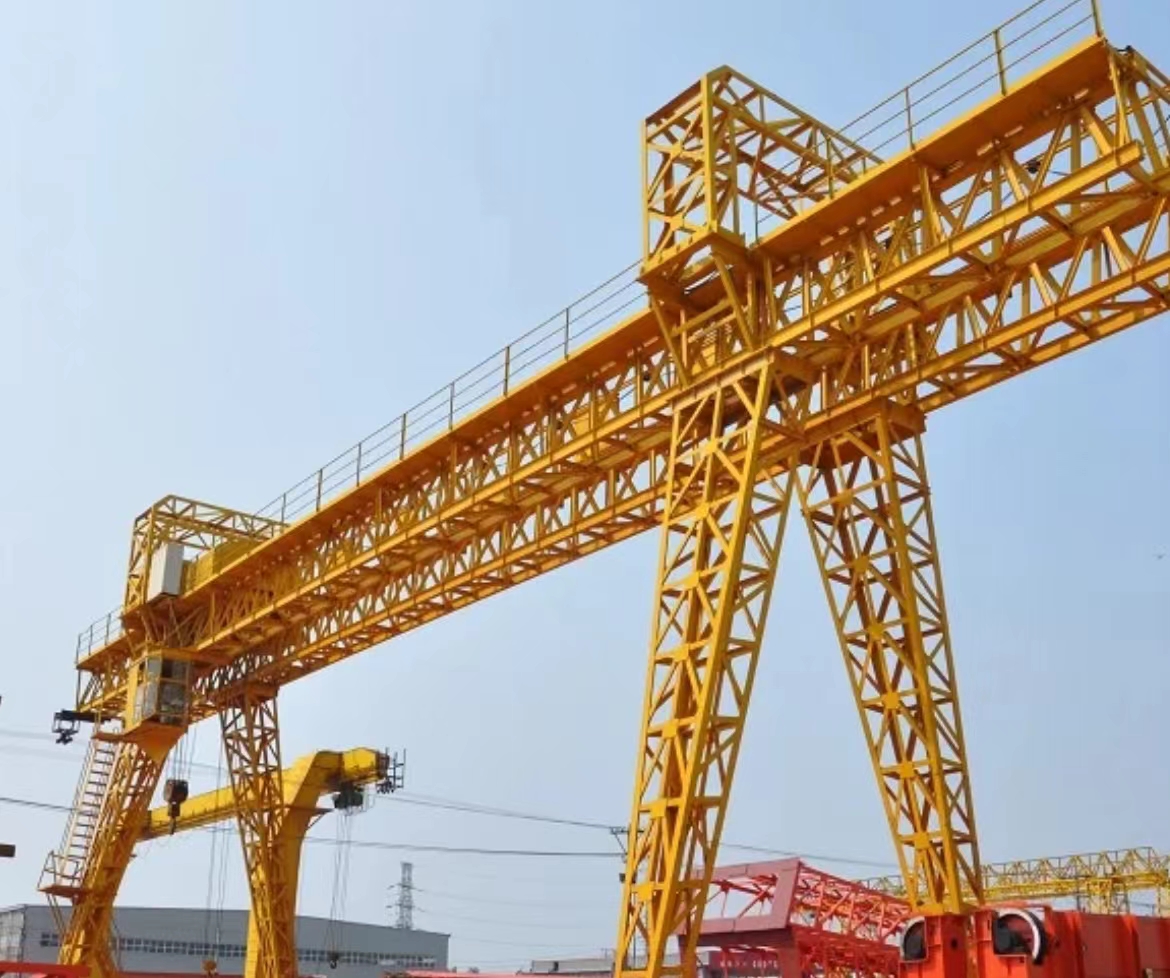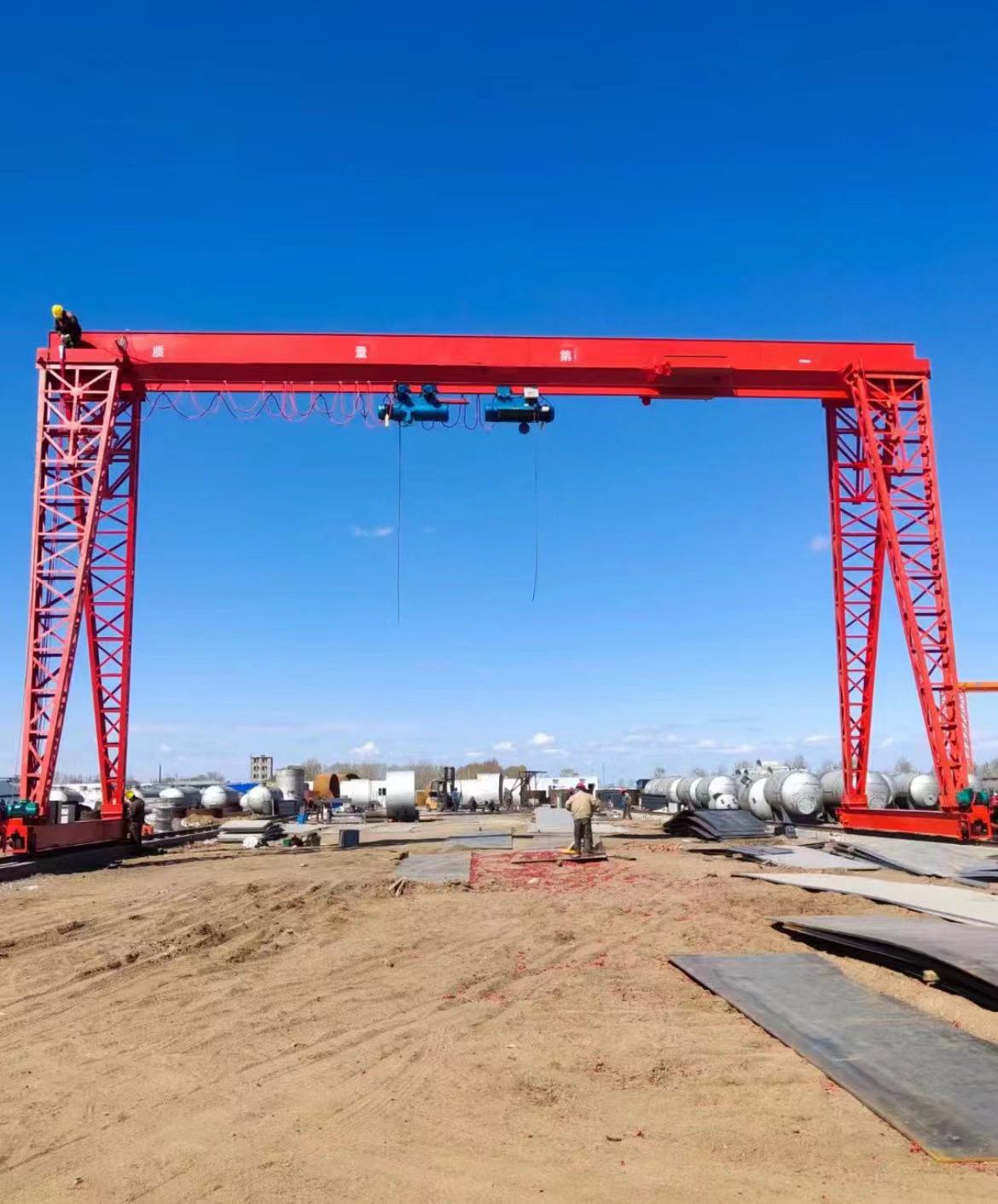Working principle of gantry crane
Gantry crane is a kind of heavy lifting equipment widely used in ports, shipyards, logistics centers and other places. It is mainly used to lift various large goods. Its working principle is relatively simple, but its construction and operation involve the coordinated work of multiple mechanical and electrical systems, and it has strong stability and efficiency.

1. Structural composition of gantry crane
Gantry crane is mainly composed of the following parts:
Crane trolley
This is the core part of the entire gantry crane, which is installed on the track and moved by the drive device. The trolley carries the hook or sling and is responsible for the lifting and transportation of goods.
Gantry
The bridge is a horizontal structure connecting the support towers on both sides of the crane, on which the trolley track is installed. It carries the trolley and provides support for lateral movement.
Outrigger
The outrigger is usually composed of steel structure, which mainly plays a supporting role, allowing the crane to stand stably on the ground. The outrigger is usually equipped with crawlers, tires and other devices to facilitate the movement and adjustment of the crane.
Lifting mechanism
The lifting mechanism is a key component of the crane. It consists of an electric motor, a drum, a wire rope and a hook. The motor drives the drum, and the wire rope drives the hook up or down, thereby lifting the goods.
Traveling mechanism
The traveling mechanism includes a driving wheel, a motor and a supporting device, which is responsible for moving the gantry crane forward and backward along the track. Its traveling mode is usually driven by electricity or hydraulics.
Electrical control system
The electrical control system is used to regulate the operation of various electric components, such as lifting, traveling and rotating. The accuracy and reaction speed of the control system are crucial to the working efficiency and safety of the gantry crane.
2. Working principle of gantry crane
The working principle of gantry crane can be explained from the following aspects:

Lifting action
The lifting mechanism drives the drum through the motor to wind or loosen the wire rope, thereby driving the hook up or down. The speed of the motor and the accuracy of the control system directly determine the lifting speed and accuracy of the goods.
Lateral movement
The gantry crane's trolley moves horizontally on the bridge through the track, usually driven by an electric motor. The control system will accurately adjust the movement speed and position of the trolley so that it can accurately transport goods according to the predetermined route.
Longitudinal travel
Through the traveling mechanism, the gantry crane can travel forward and backward along the fixed track, thereby realizing the longitudinal movement of the entire platform. The driving wheel of the traveling mechanism drives the crane to move through the motor or hydraulic system, ensuring the flexibility of the operating range.
Rotational action
Some gantry cranes are equipped with a rotating device that can rotate the hook or spreader at a certain angle in the horizontal plane to facilitate the precise placement of materials. The rotating mechanism is usually composed of a motor, a reducer, a gearbox, etc.
3. Workflow of gantry cranes
Material preparation
Before the operation, it is necessary to first confirm the weight, size and nature of the hoisted material to ensure that the crane has sufficient carrying capacity and stability. The crane driver will select the appropriate spreader and wire rope according to actual needs.
Lifting operation
After the spreader or hook contacts the material, the operator controls the lifting mechanism through the electronic control system to lift the material. During the lifting process, ensure that the material rises smoothly to avoid damage or safety accidents caused by shaking or loss of control.
Transportation process
The crane accurately transports the material to the designated location through the lateral movement of the traveling mechanism and the cart. The driver adjusts the crane's travel path according to the on-site environment and needs to avoid interference from obstacles.
Unloading operation
After reaching the target location, the material is slowly lowered by the lifting mechanism and placed on the designated location or platform. During the unloading process, special attention should be paid to the safety and stability of the material to avoid accidents due to improper unloading.
4. Working advantages of gantry cranes
High efficiency
Gantry cranes can quickly and efficiently complete tasks such as lifting and transportation, greatly improving work efficiency. Its large structure can carry heavier materials and is suitable for heavy-duty working environments such as ports and shipyards.
Easy to operate
Despite the complex structure of gantry cranes, modern electrical control systems allow operators to complete tasks easily. Cranes with a high degree of automation reduce human intervention and improve safety and work efficiency.
Strong stability
Since gantry cranes are usually designed as a four-point support structure, they have very good stability and can operate safely in complex environments. Especially under the harsh conditions of ports and shipyards, gantry cranes can still maintain a high operating efficiency.
Strong adaptability
Gantry cranes can be customized as needed to adapt to different types of lifting tasks. For example, some gantry cranes can be equipped with a rotating device, making lifting tasks more flexible and suitable for various complex operations.
5. Summary
Gantry cranes, as an important lifting equipment, are widely used in various industrial fields due to their unique design and efficient working principle. They achieve efficient lifting and transportation of materials through the coordinated work of the lifting mechanism, traveling mechanism and electrical control system. Under the premise of ensuring safety and stability, gantry cranes can greatly improve operating efficiency and provide strong technical support for modern ports, logistics and construction industries.

